Adams Resources & Energy, Inc. (AMEX:AE) Q2 2024 Earnings Call Transcript August 10, 2024
Operator: Good afternoon, everyone. Welcome to the Adams Resources & Energy Second Quarter 2024 Financial Results Conference Call. [Operator Instructions] As a reminder, this conference call is being recorded. Now I will turn the call over to John Beisler, Investor Relations at Three Part Advisors. Please go ahead.
John Beisler: Thank you, operator, and good afternoon, everyone. Welcome to the Adams Resources & Energy second quarter 2024 conference call. Joining me on the call today are Adams Resources & Energy President and CEO, Kevin Roycraft and the company’s EVP and CFO, Tracy Ohmart. This call is also being webcast and can be accessed through the audio link on the Investor Relations page at adamsresources.com. Today’s call, including the Q&A session, will be recorded. Please be advised that any time-sensitive information may no longer be accurate as of the date of any replay or transcript reading. I would also like to remind you that the statements made in today’s discussions that are not historical facts, including statements or expectations or future events or future financial performance, are forward-looking statements and are made pursuant to the Safe Harbor provision of the Private Securities Litigation Reform Act of 1995.
Forward-looking statements, by their nature, are uncertain and outside of the company’s control. Actual results may differ materially from those expressed or implied. Please refer to the earnings press release that was issued yesterday for our disclosures on forward-looking statements. These factors and other risks and uncertainties are described in detail in the company’s filings with the Securities and Exchange Commission. Adams Resources & Energy assumes no obligation to publicly revise or update any forward-looking statements. Management will refer to non-GAAP measures, including adjusted EBITDA, free cash flow, return on and adjusted net income and earnings per share. Reconciliations to the nearest GAAP measures can be found at the end of our earnings release.
Finally, the earnings press release we issued yesterday is posted on the Investor Relations section of our website, adamsresources.com. A copy of the release has also been included in an 8-K submitted to the SEC. Now I would like to turn the call over to the company’s President and CEO, Kevin Roycraft. Kevin?
Kevin Roycraft: Thank you, John, and good afternoon, everyone. Thank you for your continued interest in Adams. I will begin today’s call with some details on the quarter before turning it to Tracy for a more in-depth dive into the financials. I will then close the prepared remarks by discussing the outlook for the third quarter and for the full year 2024. Tracy; Greg Mills, our GulfMark Asset Holdings Division President; and I will be available for your questions at the conclusion of the prepared remarks. While I’m encouraged by our sequential quarter-over-quarter improvement, there is still work to do as our results are not meeting the company’s current potential. Our operating results for the first 6 months of the year reflect the combination of an extended period of weak freight demand driving down rates, lower drilling activity in our primary basin and an ongoing operational cost inflation.
When adjusted for noncash inventory losses, consolidated second quarter results were generally flat when compared to Q1. However were it not for an additional $0.8 million of self-insured retention expense primarily from a trucking incident that occurred in the quarter, the quarter-over-quarter performance and EBITDA would have been much improved. EBITDA for the second quarter when adjusted for inventory valuation and additional insurance expense was $5 million versus adjusted EBITDA of $4.2 million in Q1. Despite these challenges, we are continuing to improve our overall financial position. For four consecutive quarters, we have increased the company’s cash and liquidity positions. Adams’ available cash grew by $1.9 million versus Q1, ending the second quarter with $38.5 million in unrestricted cash.
Over that same time period, we also improved our liquidity by $4.9 million from $83.6 million at March 31, 2024, to $88.5 million. Additionally, in the quarter, we were able to make $3 million of accelerated principal payments towards our $25 million term loan that was used to repurchase the KSA shares. At the end of the quarter, the remaining balance of the loan was $15.6 million. Our crude oil marketing segment, GulfMark Energy, was certainly a bright spot for the company in Q2. GulfMark saw a significant quarter-over-quarter improvement as they experienced growth in both margins and volumes. Volumes in our legacy trucking area, which includes South Texas, Michigan and Louisiana, grew from 64,634 barrels per day to 67,099 barrels per day.
Approximately 80% of the company’s EBITDA for the quarter came from GulfMark’s performance. GulfMark’s strong performance helped the VEX Pipeline achieve improved results as well. The volume on the line has grown by over 20% in each of the previous two quarters. Throughput reached 13,881 barrels per day in Q2, up from 11,256 barrels per day in the first quarter of this year and 9,377 barrels per day in Q4 of 2023. This increase was primarily driven by GulfMark routing volumes through the VEX system and by third-party revenue gain from customers utilizing our terminalling services. As I have discussed on our previous call, the weakness in our hydrocarbon repurposing segment, Phoenix Oil, continued in the second quarter. This slowdown, due to reduced acceptance of truck deliveries for one of their primary products, is expected to be alleviated late in Q3 as Phoenix will be offering product delivery by barge.
Phoenix has leased tankage on the Houston Ship Channel that is currently being filled with product. And we expect barge deliveries to begin in Q3. This ability to deliver by barge is expected to open up new markets for Phoenix’s products and improve their margins. Our crude oil transportation hauler, Firebird Bulk Carriers, quarterly results suffered from the additional self-insured retention expense mentioned previously on this call. Quarter-over-quarter, our volumes remained fairly flat, but the impact of this expense on this tight margin business was too much to overcome to achieve our targets. Firebird will look to reducing expenses and improving efficiencies to combat softening rig counts in the Eagle Ford. Our over-the-road chemical hauling division, Service Transport Company, showed mild sequential quarter improvement as mileage and load count ticked positive.
However, revenue was slightly down as we experienced an increase in the number of short-haul loads, and rate reductions took effect as customers’ RFPs came along. While it is encouraging to see quarter-over-quarter improvements, demand and rates will need to return to 2022 levels for Service Transport to meet its profitability goals. We do expect capacity to tighten as struggling carriers exit the market. This should help lay the groundwork for increased rates in the second half of the year. I will touch on the outlook for Q3 and 2024 later, but we’ll now turn the call over to Tracy for a deeper dive into the financials. Tracy?
Tracy Ohmart: Thank you, Kevin, and good afternoon, everyone. Total revenue for the second quarter of 2024 was $718.5 million compared to $624.8 million in the prior year quarter. The increase was primarily driven by an increase in the market price of crude oil, partially offset by lower crude oil volumes. The increase in crude oil price was primarily due to OPEC oil production cuts and U.S. inventory draws from the Mid-Continent and Gulf Coast as well as events in Ukraine and Israel, which may have resulted in volatility in crude oil prices. Looking at the quarter by individual segments. Second quarter revenues for our marketing segment were $682.8 million compared to $585.3 million in the prior year quarter. This increase is primarily a result of an increase in the market price of crude oil.

Operating income for the quarter for the marketing segment was $5.6 million compared to $3.4 million in the second quarter of 2023. The increase is due to inventory valuation changes and increase in the average market price of crude oil and lower operating costs related to the expiration of the Red River contract at the end of October 2023, partially offset by lower crude oil volumes from the Red River contract termination. Our transportation segment reported $22.8 million of revenue in the second quarter compared to $24.5 million in the prior year quarter. Operating income was $637,000 versus $1.1 million for the second quarter of 2023. The decrease in revenue is primarily due to a decrease in volumes in transportation rates during 2024 as a result of the softening in the transportation market due to changes in demand, supply chain issues and inflation.
Our pipeline and storage segment reported minimal revenues after offsetting the intersegment revenues from our crude oil marketing segment. Operating losses for the quarter were $1.1 million versus a loss of $779,000 for the second quarter of 2023. The wider loss is primarily due to lower revenues from third-party customers, increases in operating salaries and wages and other related personnel expenses as well as outside service costs. Our logistics and repurposing segment, which consists of Firebird and Phoenix, reported revenues of $12.9 million compared to $14.8 million in the prior year quarter. Firebird’s revenues increased primarily due to increased transportation rates in the current period, while Phoenix’s revenue decreased due to lower volumes and activity.
The segment reported an operating loss of $2.9 million compared to a loss of $133,000 in the prior year quarter. Firebird’s results also include additional self-insured retention expense, as Kevin mentioned earlier. General and administrative expenses were $4.5 million compared to $1.7 million for the second quarter of 2023. The prior year quarter included a $2.6 million favorable adjustment related to the reduction of the contingent consideration accrual for the Firebird and Phoenix acquisition in 2022. Excluding the favorable adjustment from last year, our G&A expenses are only up slightly compared to last year’s second quarter. Interest expense decreased to $671,000 for the second quarter of 2024 versus $802,000 in the prior year quarter primarily due to lower borrowings in the 2024 period as we continue to repay amounts outstanding under our term loan, partially offset by higher amounts outstanding under finance lease obligations in the 2024 period.
Net loss for the quarter was $2.2 million or $0.87 per share compared to net income of $827,000 or $0.32 per diluted share in the second quarter of 2023. Cash provided by operating activities was $8.3 million for the second quarter of 2024 compared to $27.3 million of cash used in operating activities in the prior year quarter. This increase in operating cash flows was primarily due to changes in our working capital accounts. Capital expenditures for the quarter totaled $2.4 million primarily from the purchase of tractors, trailers and other various equipments and spending for the continuing construction of the Dayton facility. As Kevin previously mentioned, our unrestricted cash and cash equivalents at June 30, 2024, totaled $38.5 million compared to $33.3 million on December 31, 2023.
Total liquidity as of June 30 was $88.5 million versus $80.3 million at December 31, 2023. Now I’ll turn the call back over to Kevin for some final comments. Kevin?
Kevin Roycraft: Thank you, Tracy. Turning to the outlook for the third quarter and for full year 2024, the first week of Q3 got off to a challenging start as Hurricane Beryl impacted all of our Houston area operations. Though we were spared any significant damage, many of our locations as well as our customers and our vendors’ locations were without power for the – most of the first full week of July. We were able to make up the majority of Beryl’s impact on volumes and missed GulfMark barrels as well as came back online. And Service Transport experienced a spike in load count as chemical plants work through their logjam of orders. So we do not expect a material impact on Q3 results from the effects of Hurricane Beryl.
We will continue our efforts to control costs and improve operational efficiencies in all of our divisions as we are seeing signs that the markets we serve are awakening. Even with drilling activity slowing in our legacy areas, GulfMark has experienced steady improving margins throughout the year. We expect strong margins for GulfMark to continue into the third quarter. VEX Pipeline’s performance will generally follow GulfMark’s volume trends. Finding consistent third-party shippers has been elusive. However, we will continue to work to secure third-party barrels. Once drilling activity in the area improves and our potential partners complete their capital projects, we are optimistic that we will see an increase in VEX’s performance. For now, VEX provides tremendous operational efficiency for the company by moving 60 to 70 truckloads of crude each day by pipe instead of traditional semi-transportation.
This equates to approximately 1.9 million miles of cost and risk being kept off the roads annually. We expect our hydrocarbon repurposing business, Phoenix Oil, will begin to see improved results in the back half of the year. As I mentioned previously, barge delivery should begin mid-third quarter. This is expected to open up new product delivery markets. Also, construction in our Dayton, Texas rail transfer yard is well underway. We aim to have the rail spur on this property up and running in the fourth quarter. This new rail spur will enhance the cost effectiveness and efficiency for Phoenix by cutting the expenses associated with trucking products from our leased rail location to our storage facility, which is 24 miles west in Humble, Texas.
With the rail spur, products can be directly unloaded from railcars into our storage tank, eliminating both the trucking cost and the rail lease expense. We will relocate all of Firebird’s trucking operations upon the full completion of this project and anticipate achieving that by late 2025. As for Firebird, we do not see drilling activity significantly increasing in the Eagle Ford basin in the back half of the year. For this reason, we expect Firebird’s hauling volumes to be flat or slightly lower in Q3, which is in line with normal production declines. Firebird will continue to work on cost control and operational efficiency in anticipation of a more robust drilling activity in 2025. Turning to our chemical transport division, Service Transport, for the first time since the freight recession began in 2022, we are hearing some optimism in the freight markets.
Many analysts are predicting that the bottom has been reached and that we are moving towards recovery possibly by this fall, but almost certainly by the early stages of 2025. Enough carriers have exited the trucking industry to shrink available hauling capacity, which has grown the number of carrier load offer rejections and increased the rates in the spot markets. Early returns in Q3 for Service Transport support these predictions. Post Hurricane Beryl, chemical shipment volumes have increased, and Service Transport has had some early success securing targeted rate increases from portions of our customer base. It will take some time to reverse the damage that has been done from the declining rate markets over the past 2 years, but we will see – we are seeing a light at the end of the tunnel, and it appears that recovery may be approaching.
In closing, while I am pleased with the sequential operational improvements as a company, the progress has been too slow, and we have more work to do. We believe freight markets will improve as capacity continues to exit the marketplace and increasing demand returns. This should drive more disciplined pricing decisions in the industry as a whole and improve financial results. We also believe that drilling in our primary basins will increase as production and energy demands grow. Both freight demand and increased drilling are critical components towards Adams reaching and surpassing our historical operating results. Our current expectation on the timing of these improvements extends into 2025. As we prepare for markets to revive, all divisions will continue to work on the – work to control cost and improve operational efficiencies.
We believe in the long-term strength of our organization, and the foundation that we have established allows us to make it through weak markets and thrive when market conditions improve. We are thankful for the team at Adams, especially our professional drivers, and look forward to delivering improved results to drive value to our shareholders. With that, I would like to open the line for questions. Operator?
Q&A Session
Follow Adams Resources & Energy Inc. (AMEX:AE)
Follow Adams Resources & Energy Inc. (AMEX:AE)
Receive real-time insider trading and news alerts
Operator: [Operator Instructions] And our first question today comes from Chris Sakai with Singular Research. Please go ahead.
Chris Sakai: Yes. Hi. Good afternoon. I just wanted to ask what sort of catalysts do we see to be optimistic about conditions in the chemical transportation market, is improving in the latter half of 2024 and early 2025?
Kevin Roycraft: Yes, that’s a great question, Chris. I appreciate it. What we have seen is some data showing the number of turndowns by carriers has been increasing. So, in 2021, for example, overall in the industry, carrier turndowns, when an offer – when a load is offered to them and they give it back, was around 25% of all loads. And then as the recession – the freight recession started to hit, that’s been dropped to between 3% and 5% over the last 2 years and really has flat lined in Q4, and we are starting to see that tick up. And so the analysts that we were looking at were saying this is possibly, not definitely, but possibly a sign that the capacity is shrinking. And also, the data surrounding the number of trucking companies exiting the market either through bankruptcies or just closing and getting away from it, is creating a – is starting to create a capacity shortage.
And the thing that gives us some hope on that is that Service Transport is having some success for the first time in 2 years, being able to take some targeted rate increases. It will take a lot of time to recover from the rates that have been really hit hard over the last 2 years, but we are seeing customers in pockets where capacity is getting tight start to agree to rate increases. So, we see that as a positive sign because we really haven’t been in a rate-increasing mode in a couple of years.
Chris Sakai: Okay. Great. And then looks like there was some great throughput from the VEX Pipeline in the second quarter. How should we be thinking about this throughput for the rest of the year?
Kevin Roycraft: Yes. Maybe I will turn that one over to Greg. Greg, do you want to take that one?
Greg Mills: Sure Kevin. Thank you. We see volumes probably consistently moving where they are and where they have been, but we are not seeing quite as many flowbacks. I would say the volume that we experienced in the second quarter and even the first quarter this year was helped out by some producer flowbacks. And so I think where we are headed with VEX is at a comfortable level, but not maybe quite as high on the volume that we saw in 2Q, but yet still steady volume.
Chris Sakai: Okay. Great. And is that – would that be the same for the terminalling volumes as well?
Greg Mills: Yes, with respect to GulfMark and the terminalling volume into the pipeline, that will stay steady. We do not have some of the third-party revenue at the Victoria terminal moving forward into this quarter. So, we will see that drop off a bit.
Chris Sakai: Okay. Great. Thanks for the answers.
Operator: [Operator Instructions] And this concludes our question-and-answer session. I would like to turn the conference back over to the company for any closing remarks.
Kevin Roycraft: Thank you and thank you for your continued interest in Adams. We will be participating in the Three Part Advisors IDEAS Conference in Chicago on August 28th. Qualified investors that would like to attend or schedule a meeting with Tracy and I should contact Three Part Advisors. We look forward to providing an update on our progress when we report our third quarter earnings in November. Thank you for joining us.
Operator: Thank you. This concludes today’s conference call. We thank you all for attending today’s presentation. You may now disconnect your lines, and have a wonderful day.
Follow Adams Resources & Energy Inc. (AMEX:AE)
Follow Adams Resources & Energy Inc. (AMEX:AE)
Receive real-time insider trading and news alerts





